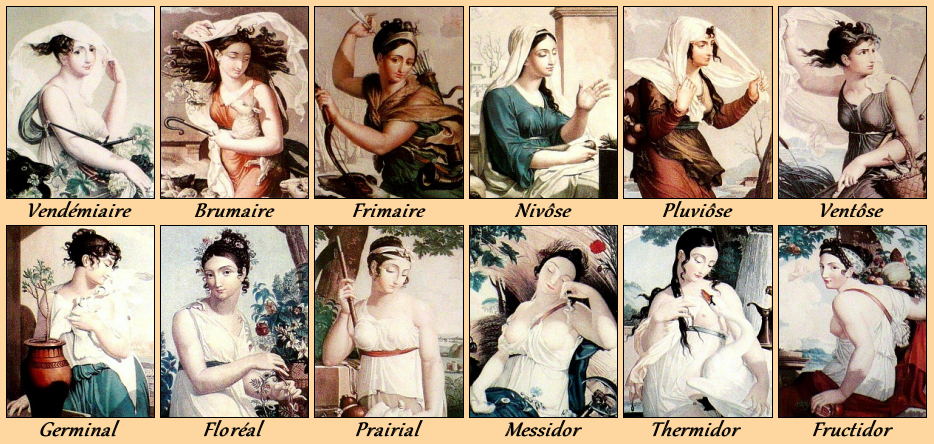The French Republican calendar
Date converter: Revolutionary calendar / Gregorian
To convert a date in the Revolutionary calendar into the same one in the Gregorian calendar, or vice versa, please enter the desired date then click the button corresponding to your request.
Dates are accepted from 15 Vendemiaire year II (October 6, 1793), the date of entry into force of the Republican calendar by decree of the National Convention, to 10 Nivose year XIV (December 31, 1805), the last day of its use.
An ephemeral legacy of the French Revolution
Throughout the Consulate, and until the end of 1805, the French continued to live, at least officially, to the rhythm of the calendar conceived by Philippe Francois-Nazaire Fabre d'Eglantine. This system would finally be abandoned on 22 Fructidor year XIII (9 September 1805) by an imperial sénatus-consulte, following a report from Pierre-Simon Laplace, which restoring the Gregorian calendar from 1 January 1806.
Each year, which began on the day of the autumnal equinox, was divided into twelve months of thirty days, themselves divided into three equal parts of ten days each, called decades. The days of the week also disappeared, those of the decade being named primidi, duodi, tridi, quartidi, quintidi, sextidi, septidi, octidi, nonidi and décadi (the latter being a day of rest).
These twelve months, which therefore total 360 days, were followed at the end of the year by five additional days (six days in leap years, called sextile years).
Year I [An I] started on September 22, 1792 (which had been subsequently adopted by the National Convention, precisely during the session of October 5, 1793).
The months were named in a way that evoked their usual weather conditions, or the agricultural activities practiced during them. These months were:
- Vendémiaire - From September 22/23/24 to October 21/22/23. Its name evoked the grape harvest. The nickname "General Vendémiaire" would, for a time, be given to Napoleon Bonaparte who had led the repression of the royalist uprising on the 13th of this month, in the year IV.
- Brumaire - From October 22/23/24 to November 20/21/22. Its name evoked fogs. A famous date was 18 Brumaire Year VIII, the first day of Napoleon Bonaparte's coup d'état, which had continued into the next day.
- Frimaire - From November 21/22/23 to December 20/21/22. Its name evoked cold.
- Nivôse - From December 21/22/23 to January 19/20/21. Its name was referring to snow.
- Pluviôse - From January 20/21/22 to February 18/19/20. Its name evoked rain.
- Ventôse - From February 19/20/21 to March 20/21. Its name evoked the wind.
- Germinal - From March 21/22 to April 19/20. Its name evoked the development of sap. This month would be the title of one of the most famous novels by french writer Émile Zola, published in 1885.
- Floréal - From April 20/21 to May 19/20. Its name was related to flowering.
- Prairial - From May 20/21 to June 18/19. Its name evoked the harvest of the meadows.
- Messidor - From June 19/20 to July 18/19. Its name recalled the wheat harvest.
- Thermidor - From July 19/20 to August 17/18. Its name evoked heat. A historic date was 9 Thermidor year II, the day of the fall of Maximilien Robespierre, who will be guillotined the next day. In gastronomy, the seafood dish "Lobster Thermidor" was named after the 1891 play Thermidor, set during the French Revolution.
- Fructidor - From August 18/19 to September 16/17. Its name evoked fruits.
The following five days were called the Sans-culottides, in reference to the Sans-culottes, lower class militant partisans of the French Revolution, wearing (often striped) long trousers and not knee-breeches ("culottes" in French) and stockings like aristocrats and bourgeois did. These days were named "Virtue Day" (September 17/18), "Genius Day" (September 18/19), "Labor Day" (September 19/20), "Opinion Day" (September 20/21) and "Awards Day" (September 21/22); the sixth day, once every four years, was called "Revolution Day".
Unlike the metric system, which will be adopted by (almost) the entire world, this is the most emblematic example of a new unit which had not passed down to posterity, despite an use which lasted 12 years, 2 months and 27 days.
